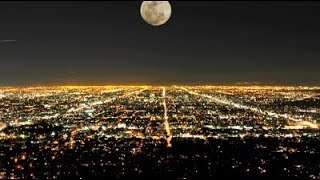
When light of any kind shines through a dense medium it appears larger, or rather gives a greater glare, at a given distance than when it is seen through a lighter medium. This is more remarkable when the medium holds aqueous particles or vapor in solution, as in a damp or foggy atmosphere. You can see this by standing within a few yards of a street lamp, and noticing the size of the light; on going away to many times the distance, the light upon the atmosphere will appear considerably larger. This phenomenon may be noticed, to a greater or less degree, at all times; but when the air is moist and vapory it is more intense. It is evident that at sunrise, and at sunset, the sun’s light must shine through a greater length of atmospheric air than at mid-day; besides which, the air near the earth is both more dense, and holds more watery particles in solution, than the higher strata through which the sun shines at noonday; and hence the light must be dilated or magnified, as well as modified in color. So the Sun as it sets towards the horizon, from a viewer’s perspective on Earth, simultaneously gets bigger due to the reason given above, AND smaller due to the law of perspective. The net result is what you see.
http://www.EricDubay.com
http://www.AtlanteanConspiracy.com
http://www.IFERS.123.st


